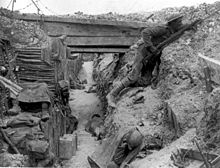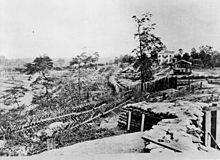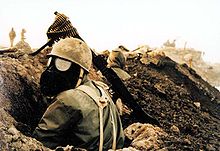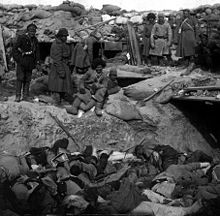Trench warfare
![]()
This article is about the modern form of war. For the attack on Medina in 627, see Battle of the Trenches.
Trench warfare is a type of positional warfare in which two opposing frontal fortifications each consist of a system of trenches and barrel trenches. These frontal fortifications were caused by opposing opposing troops of almost equal strength meeting in opposite directions of attack, both of which had technically advanced artillery with effective shells and long gun ranges at their disposal, as well as the newly developed machine guns of the time. At the same time, however, the mobility of the new heavy weapons in particular remained low in the mostly impassable terrain, especially since the draught animals needed for the advance were just as exposed to the increased weapon effect as the people.
Major trench warfare first occurred in 1854 during the Crimean War, where the application of this defensive concept was pioneered by Russian engineer officer Franz Totleben.
In the period that followed, trench warfare was also used, particularly in the American Civil War (1861-1865) and the Russo-Japanese War (1904-1905).
This type of warfare reached its bloody peak in the trench warfare of the First World War. In the Battle of Verdun alone, over 700,000 soldiers were killed or wounded from February to December 1916. The fighting failed to significantly alter the course of the front. The Battle of Gallipoli also saw a freezing of the fronts and trench warfare after the amphibious landing. In order to avoid the high losses associated with this, the tactic of mobile combat with armoured vehicles was developed in Europe and the USA in the interwar period and applied in the major tank battles at the beginning of the Second World War.
Still in the Second World War the mass of the infantry was not motorized. Battles often still took place around and with field positions. The end of this type of combat came with the rapid tank advances in the war of movement, which had the goal of penetrating deep into the enemy's battle space through gaps and weak points in the defense and there encircle units of the enemy infantry and cut them off from supplies and the rest of the troops.
Even in the Iran-Iraq War (1980-1988), trench warfare in open field positions resulted in heavy losses, since the difficult terrain and the low level of mechanization precluded a war of movement.
The term trench warfare is often used metaphorically to describe situations in which disputing parties make the same accusations to each other over and over again in slightly different forms, without taking a closer look at what is being said to them and without addressing it, which leads to no progress in the discussion and to no agreement.

British trench in the First World War (1916) .
Background
Cordons (border fortifications) were already built in antiquity, but it was usually not possible to defend more than one section due to the limited size of armies and short range of weapons. The great fortifications of antiquity, such as Hadrian's Wall (England), the Limes (Germany) or the Great Wall of China, are rather exceptions to the rule and served primarily to make the crossing of the border more difficult and to control it, but not to prevent it completely.
Field fortifications were rarely used in open field battles, as their construction takes considerable time. Field battles were comparatively short; the losing party often retreated to a fortress, which was then besieged. Nevertheless, even the Arab Muslims used Medina's trenches (Trench Battle of 627) to defend against cavalry.
Although both fortification and armament underwent massive development in the second half of the second millennium, even the introduction of firearms did not initially fundamentally change the fact that fortifications required large numbers of troops to defend them. Smaller units could not generate the necessary firepower to stop an attack.
The introduction of artillery already in the times of the Ottoman Empire and the battles that took place as in the siege of Vienna had a massive influence on the construction of the fortress and the siege. The attacking infantry was forced to approach the fortress in Approchen (approach trenches).
Important for the emergence of positional warfare and thus trench warfare was the introduction of large conscript armies at the time of the French Revolution and the Napoleonic Wars. Large armies made it more difficult to outmaneuver the enemy and attack the flanks. In particular, the introduction of machine guns such as the Gatling repeating gun made it increasingly necessary for infantry in field positions to protect themselves from attack and fire, including from increasingly effective artillery.
For trench warfare, in addition to field emplacement, the use of ground obstacles such as S-wire, Spanish Riders and Crow's Feet, and today, Bandstacheldraht, became increasingly important.
Wars with trench warfare
Crimean War
Before the siege of Sevastopol, the Russians had provisional trench systems built to defend the city. Rifles with rifled barrels (e.g. Enfield Rifled Musket) were used for the first time, which could be used to hit at a long distance. Although known for some time, the effectiveness of hand grenades was recognized in trench warfare.
War of Secession
The War of Secession was fought at the beginning with tactics from the Napoleonic era, but towards the end the war became a preview of the First World War. Thus, field fortifications became very important. These included the Spanish cavalry made of pointed wooden stakes, but also the first land mines. The Battle of Cold Harbor is considered the first open field battle, i.e. not a siege, which solidified into a trench warfare.
The Atlanta Campaign and the Siege of Petersburg near the end of the Civil War, with their trenches, were in marked contrast to early battles such as the First Battle of Bull Run.
Russo-Japanese War
The Russo-Japanese War (1904-1905) saw the first use of barbed wire and machine guns in the siege of Port Arthur. Infantry were also consistently equipped with breechloaders, which allowed a small force to unleash greater firepower. A small group of defenders could thus repel attackers much more easily with proper cover.
First World War
Main article: Trench warfare in World War I
With the outbreak of war, troops realized that the smallest amount of cover enabled the defender to repel an enemy attacking head-on. Frontal attacks resulted in dramatic casualties; therefore, flank attacks were seen as the only way to win. This led to a series of encircling maneuvers after the Battle of Marne, which ended only when both armies reached the coast. The trench system of the Western Front stretched from the North Sea to Switzerland.
After the First World War, trench warfare occurred only very rarely.
Second World War
The Second World War was characterized by the war of movement of mechanized troops and the air war on both the operational and tactical level, in the beginning mostly against an opponent who relied on fortifications and field positions such as the Maginot Line in France or the Metaxas Line in Greece. These were usually quickly broken through.
Nevertheless, even the Wehrmacht in the Russian campaign secured and defended larger sections of the front by infantry in extended field positions and bunker lines over longer periods of time and tried to compensate for a lack of mobile combat power with the Atlantic Wall. Each of these defensive systems could usually be breached by the attacker within a few hours and render the other adjoining sections obsolete.
This was also evident in the Indochina War as in the Battle of Điện Biên Phủ and the Korean War.
Iran-Iraq War
The most famous example of trench warfare after World War I was the Iran-Iraq War. In this war, both sides had a large infantry army, but very little armored vehicles, aircraft, or the necessary training. The result was a battle comparable to World War I, with trenches and the use of chemical weapons.
Eritrea-Ethiopia War
Another example is the war between Ethiopia and Eritrea, which also primarily involved infantry units.

Spanish horsemen and palisades in the Atlanta area during the War of Secession (1864).

Siege of Sevastopol

Soldier in the Iran-Iraq War, which was also marked by Iraq's use of chemical weapons.

Trench in the Russo-Japanese War (1905)
Questions and Answers
Q: What is trench warfare?
A: Trench warfare is a war tactic or way of fighting that was commonly used on the Western Front during the First World War and in other wars, such as the Iran-Iraq War. It involves two sides digging trenches in a battlefield with different parts for sleeping, headquarters, storage, artillery and machine guns.
Q: What is "no man's land"?
A: No man's land is an area between the front trenches on a battlefield that is often covered with barbed wire and land mines. Soldiers from each side would try to cross this area to get to the enemy's trench and attack them.
Q: Why did armies use trench warfare?
A: Armies used trench warfare because it gave soldiers cover while defending themselves against attack and also provided bunks for them to sleep in, although these were usually unclean and uncomfortable.
Q: How did soldiers cross no man's land?
A: Soldiers crossed no man's land by using tanks which could break through barbed wire and navigate around land mines safely.
Q: What was included in trenches?
A: Trenches had many different parts including places for sleeping, headquarters, storage, artillery and machine guns.
Q: Where was trench warfare commonly used?
A: Trench warfare was commonly used on the Western Front during the First World War and also in other wars such as the Iran-Iraq War.
Q: How did trenches give soldiers protection?
A: Trenches gave soldiers protection by providing cover from enemy attacks while they defended themselves.
Search within the encyclopedia